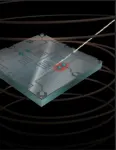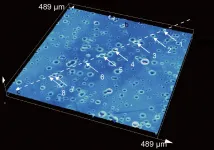(Press-News.org) Human babies do even more than we thought while sleeping.
A new study from University of Iowa researchers provides further insights into the coordination that takes place between infants' brains and bodies as they sleep.
The Iowa researchers have for years studied infants' twitching movements during REM sleep and how those twitches contribute to babies' ability to coordinate their bodily movements. In this study, the scientists report that beginning around three months of age, infants see a pronounced increase in twitching during a second major stage of sleep, called quiet sleep.
"This was completely surprising and, for all we know, unique to humans and human infants," says Mark Blumberg, F. Wendell Miller Professor and chair in the Department of Psychological and Brain Sciences and one of the study's authors. "We were seeing things that we could not explain, based on our years of observation in baby rats and what's available in the scientific literature."
The researchers recorded 22 sleeping infants, ranging from one week of age to seven months, and their twitches. At first, the scientists paid attention solely to the twitches occurring alongside REM sleep, in keeping with their previous research of REM sleep-associated twitching in other mammals.
But then the surprise happened: The researchers noticed the infants were twitching their limbs outside of REM sleep as well.
"The twitches looked exactly the same," says Greta Sokoloff, research scientist in the Department of Psychological and Brain Sciences at Iowa and the study's lead author. "We did not expect to see twitches during quiet sleep--after all, quiet sleep got that name because humans and other animals typically don't move during that state."
Because the researchers were recording brain waves in the sleeping babies, they were able to study brain activity associated with the twitches. As expected, they noticed that during quiet sleep, the infants produced large brain oscillations--called sleep spindles--about once every 10 seconds.
Sleep spindles offer a window into the brain's coordination with its motor system. The researchers found the rate of sleep spindles in the infant subjects increased beginning around three months to seven months of age and were concentrated along the sensorimotor strip, where the cortex processes sensory and motor information. These facts about sleep spindles were particularly important once the researchers discovered that the sleep spindles and twitches were synchronized.
"Sleep spindles have been widely linked with learning and memory," Sokoloff says. "So our findings suggested to us that what the infants are doing is learning about their bodies through twitching during a period of sleep that we previously thought was defined by behavioral silence."
The finding opens a whole new avenue of research into the brain-body communication that takes place while infants are asleep.
"Our finding could reflect something important about the cortical contributions to motor control," Blumberg says. "Infants have to integrate the brain with the body, to get the system set up and working properly. It's not all connected at birth. There's a lot of development that has to happen after birth. What we think we're seeing is a new mode of integration among different parts of the brain and the body."
The researchers note the study has a small sample size, especially at the younger ages, and the infants were recorded during short periods of daytime sleep. They plan to recruit more infants and study their sleep during the day and night to confirm the findings.
INFORMATION:
The study, "Twitches emerge postnatally during quiet sleep in human infants and are synchronized with sleep spindles," was published online June 10 in the journal Current Biology.
Contributing authors from Iowa include James Dooley, Ryan Glanz, Rebecca Wen, Meredith Hickerson, Laura Evans, Haley Laughlin, and Keith Apfelbaum.
The National Institute of Child Health and Human Development, a branch of the National Institutes of Health, funded the research.
When Betelgeuse, a bright orange star in the constellation of Orion, lost more than two-thirds of its brightness in late 2019 and early 2020, astronomers were puzzled.
What could cause such an abrupt dimming?
Now, in a new paper published Wednesday in Nature, an international team of astronomers reveal two never-before-seen images of the mysterious darkening --and an explanation. The dimming was caused by a dusty veil shading the star, which resulted from a drop in temperature on Betelgeuse's stellar surface.
Led by Miguel Montargès at the Observatoire de Paris, the new images were taken in January and March of 2020 using the European Southern Observatory's Very Large Telescope. Combined with images previously taken in ...
EMBARGOED UNTIL 11 A.M. ET WEDNESDAY, JUNE 16, 2021
MADISON, Wis. -- Quantum computers could outperform classical computers at many tasks, but only if the errors that are an inevitable part of computational tasks are isolated rather than widespread events. Now, researchers at the University of Wisconsin-Madison have found evidence that errors are correlated across an entire superconducting quantum computing chip -- highlighting a problem that must be acknowledged and addressed in the quest for fault-tolerant quantum computers.
The researchers report their findings in a study published June 16 in the journal Nature, Importantly, their work also points to mitigation strategies.
"I think people have been approaching the problem of error correction in an overly optimistic ...
It is possible to re-create a bird's song by reading only its brain activity, shows a first proof-of-concept study from the University of California San Diego. The researchers were able to reproduce the songbird's complex vocalizations down to the pitch, volume and timbre of the original.
Published June 16 in Current Biology, the study lays the foundation for building vocal prostheses for individuals who have lost the ability to speak.
"The current state of the art in communication prosthetics is implantable devices that allow you to generate textual output, writing up to 20 words per minute," said senior author Timothy Gentner, a professor of psychology and neurobiology ...
When Betelgeuse, a bright orange star in the constellation of Orion, became visibly darker in late 2019 and early 2020, the astronomy community was puzzled. A team of astronomers have now published new images of the star's surface, taken using the European Southern Observatory's Very Large Telescope (ESO's VLT), that clearly show how its brightness changed. The new research reveals that the star was partially concealed by a cloud of dust, a discovery that solves the mystery of the "Great Dimming" of Betelgeuse.
Betelgeuse's dip in brightness -- a change noticeable even to the ...
What The Study Did: Researchers examined to what extent cannabis use is associated with thickness in brain areas measured by magnetic resonance imaging in a study of adolescents.
Authors: Matthew D. Albaugh, Ph.D., of the University of Vermont Larner College of Medicine in Burlington, is the corresponding author.
To access the embargoed study: Visit our For The Media website at this link https://media.jamanetwork.com/
(10.1001/jamapsychiatry.2021.1258)
Editor's Note: The article includes conflict of interest and funding/support disclosures. Please see the article for additional information, including other authors, author contributions and affiliations, conflict of interest and financial disclosures, and funding and support.
INFORMATION:
Media advisory: The ...
What The Study Did: Survival among people with early-onset (diagnosed before age 50) colorectal cancer compared with later-onset colorectal cancer (diagnosed at ages 51 through 55) was compared using data from the National Cancer Database.
Authors: Charles S. Fuchs, M.D., M.P.H., of the Yale School of Public Health in New Haven, Connecticut, is the corresponding author.
To access the embargoed study: Visit our For The Media website at this link https://media.jamanetwork.com/
(doi:10.1001/jamanetworkopen.2021.12539)
Editor's Note: The article includes conflicts of interest and funding/support disclosures. Please see the article for additional information, including other authors, author contributions and affiliations, conflict of interest and financial disclosures, and funding and ...
What The Study Did: This study demonstrated an association between receiving the mRNA-1273 (Moderna) vaccine and a reduction in SARS-CoV-2 infection in health care workers beginning eight days after the first dose.
Authors: Michael E. Charness, M.D., of the VA Boston Healthcare System in West Roxbury, Massachusetts, is the corresponding author.
To access the embargoed study: Visit our For The Media website at this link https://media.jamanetwork.com/
(doi:10.1001/jamanetworkopen.2021.16416)
Editor's Note: The article includes conflict of interest ...
A ball of 4,000-year-old hair frozen in time tangled around a whalebone comb led to the first ever reconstruction of an ancient human genome just over a decade ago.
The hair, which was preserved in arctic permafrost in Greenland, was collected in the 1980s and stored at a museum in Denmark. It wasn't until 2010 that evolutionary biologist Professor Eske Willerslev was able to use pioneering shotgun DNA sequencing to reconstruct the genetic history of the hair.
He found it came from a man from the earliest known people to settle in Greenland ...
Stimulation of the nervous system with neurotechnology has opened up new avenues for treating human disorders, such as prosthetic arms and legs that restore the sense of touch in amputees, prosthetic fingertips that provide detailed sensory feedback with varying touch resolution, and intraneural stimulation to help the blind by giving sensations of sight.
Scientists in a European collaboration have shown that optic nerve stimulation is a promising neurotechnology to help the blind, with the constraint that current technology has the capacity of providing only simple visual signals.
Nevertheless, the scientists' vision (no pun intended) is to design these simple visual signals to be meaningful in assisting the blind with daily living. Optic nerve stimulation ...
Although plexiglass barriers are seemingly everywhere these days -- between grocery store lanes, around restaurant tables and towering above office cubicles -- they are an imperfect solution to blocking virus transmission.
Instead of capturing virus-laden respiratory droplets and aerosols, plexiglass dividers merely deflect droplets, causing them to bounce away but remain in the air. To enhance the function of these protective barriers, Northwestern University researchers have developed a new transparent material that can capture droplets and aerosols, effectively ...


